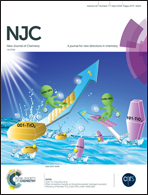A new approach towards the study of thermal decomposition and formation processes of nanoalloys: the double complex salt [Pd(NH3)4][PtCl6]†
Abstract
A new approach based on a combination of synchrotron radiation techniques, such as X-ray absorption fine structure (XAFS), X-ray photoelectron spectroscopy (XPS), hard X-ray photoelectron spectroscopy (HAXPES), and powder X-ray diffraction (PXRD), has been applied to in situ study the processes of thermal decomposition of inorganic compounds and the formation of bimetallic nanoalloys. As an example, a double complex salt, [Pd(NH3)4][PtCl6], was selected because of (i) its sufficiently complicated structure and previous studies conducted via thermal analysis, ex situ PXRD and XPS, and (ii) its use as a prospective single-source precursor for the preparation of bimetallic (PdPt) nanoparticles or nanoalloys. The differences between the mechanisms based on ex situ and in situ data have been discussed for the first time. It has been found that the first step of thermal decomposition is related to the formation of crystalline [Pd(NH3)2Cl2][Pt(NH3)2Cl4]. Further decomposition results in the formation of {PdCl2}, {PtCl2}, and (NH4)2[PtCl6] in the second step. In the final step, the intermediates are completely reduced, and a bimetallic nanoalloy is formed. The different means of Pd and Pt reduction on the surface and in the bulk result in the formation of a disordered nanoalloy with possible monometallic inclusions. Further heating orders the nanoalloy that is accompanied by a decrease in the positive charge on Pt.
![Graphical abstract: A new approach towards the study of thermal decomposition and formation processes of nanoalloys: the double complex salt [Pd(NH3)4][PtCl6]](/en/Image/Get?imageInfo.ImageType=GA&imageInfo.ImageIdentifier.ManuscriptID=C7NJ04626J&imageInfo.ImageIdentifier.Year=2018)


 Please wait while we load your content...
Please wait while we load your content...